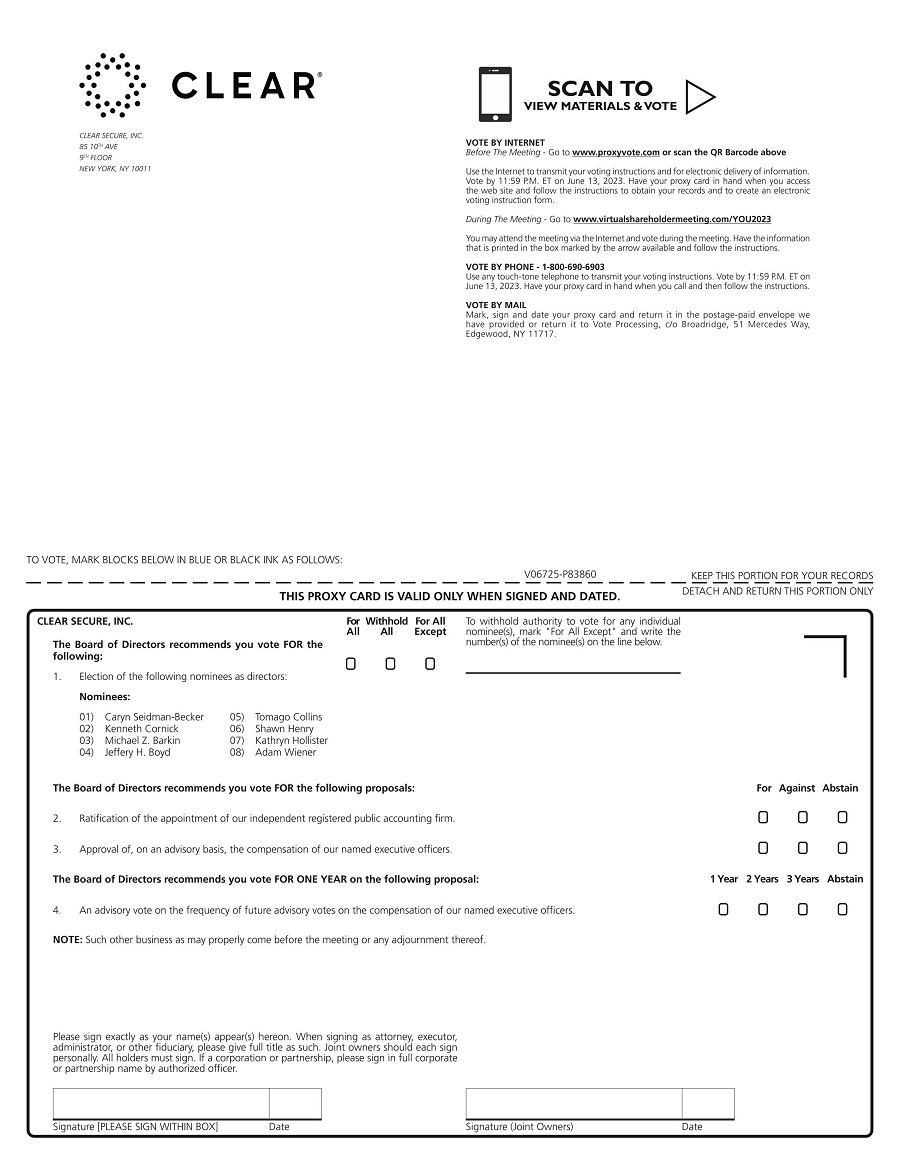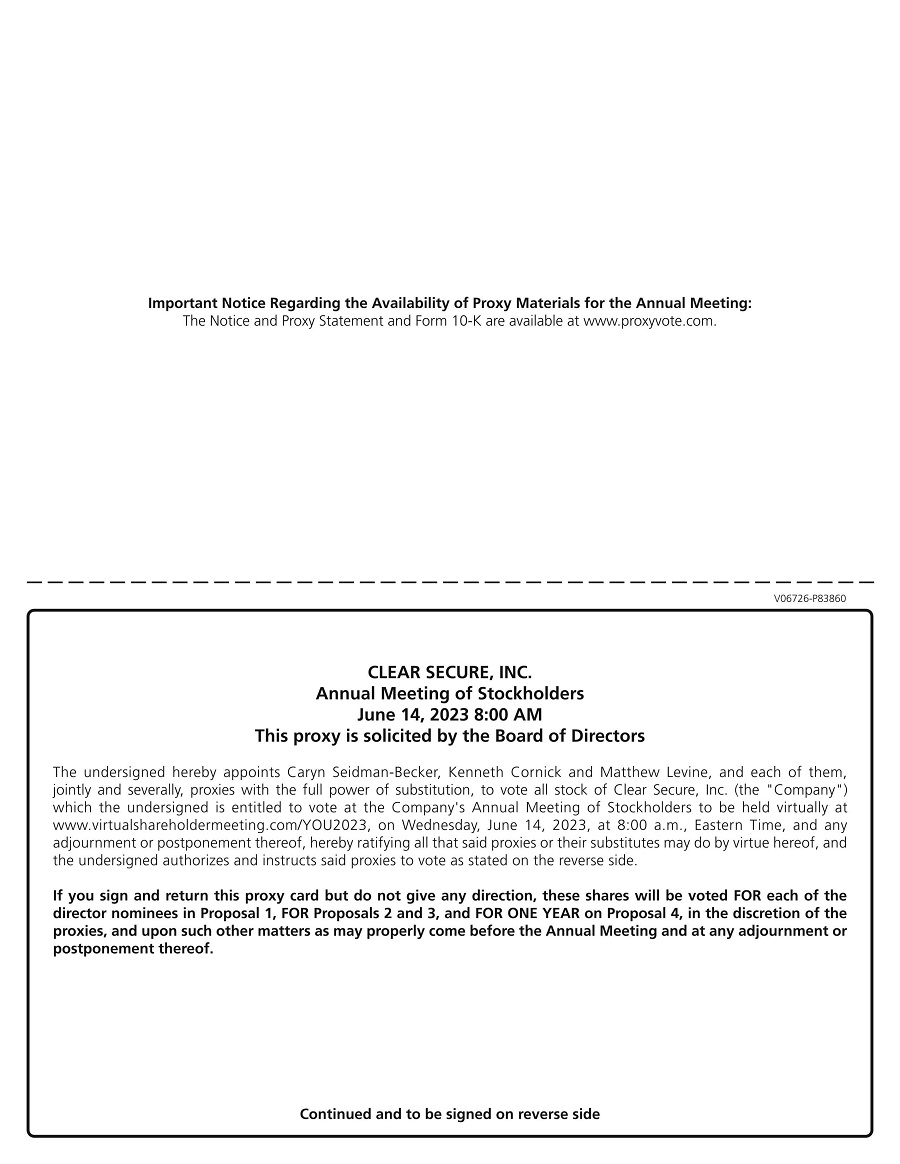| (8) |
Represents 7,792,660 shares of Class A Common Stock beneficially owned as a result of (i) 92,186 shares of Class A Common Stock held directly by GAPCO AIV Interholdco (AC), L.P. (“GAPCO AIV Interholdco”), (ii) 4,468,934 shares of Class A Common Stock held directly by GA AIV-1 B Interholdco (AC), L.P. (“GA AIV-1 B Interholdco AC”), (iii) 1,027,613 Alclear Units and an equal number of shares of Class C Common Stock held directly by General Atlantic (AC) Collections 2, L.P. (“GA AC 2 Collections”), (iv) 1,903,927 Alclear Units and an equal number of shares of Class C Common Stock held directly by General Atlantic (AC) Collections, L.P. (“GA AC Collections”), and (v) 300,000 shares of Class A Common Stock held directly by General Atlantic (ALC), L.P. (“GA ALC”). GA AC Collections and GA AC 2 Collections have the right to exchange their Alclear Units, together with a corresponding number of shares of our Class C Common Stock, for, at our option, (i) shares of our Class A Common Stock or (ii) cash from a substantially concurrent public offering or private sale of Class A Common Stock (based on the market price of our Class A Common Stock in such public offering or private sale). See “Certain Relationships and Related Party Transactions—Exchange Agreement.” The following investment funds share beneficial ownership of the shares of Class A Common Stock held by GAPCO AIV Interholdco: GAPCO AIV Holdings, L.P. (“GAPCO AIV Holdings”), GAP Coinvestments CDA, L.P. (“GAPCO CDA”), GAP Coinvestments III, LLC (“GAPCO III”), GAP Coinvestments IV, LLC (“GAPCO IV”) and GAP Coinvestments V, LLC (“GAPCO V”). The following investment funds share beneficial ownership of the shares of Class A Common Stock held by GA AIV-1 B Interholdco AC: GA AIV-1 B Interholdco, L.P. (“GA AIV-1 B Interholdco”) and General Atlantic Partners AIV-1 B, L.P. (“GAP AIV-1 B”). The following investment funds share beneficial ownership of the shares of Class A Common Stock held by GA ALC: GAPCO CDA, GAPCO III, GAPCO IV, GAPCO V, General Atlantic Partners 100, L.P. (“GAP 100”), General Atlantic Partners (Lux) SCSp (“GAP Lux”) and General Alantic Partners (Bermuda) EU, L.P. (“GAP Bermuda EU”). The following investment funds share beneficial ownership of the shares of Class C Common Stock and corresponding Alclear Units held by GA AC Collections and GA AC 2 Collections: GAPCO AIV Interholdco, General Atlantic Partners AIV (AC), L.P. (“GAP AIV AC”), GAPCO AIV Holdings, General Atlantic Partners AIV-1 A, L.P. (“GAP AIV-1 A”), GAPCO CDA, GAPCO III, GAPCO IV and GAPCO V. General Atlantic (SPV) GP, LLC (“GA SPV”) is the general partner of GAPCO AIV Interholdco, GA AIV-1 B Interholdco AC, GA AC Collections, GA AC 2 Collections, GAPCO AIV Holdings, General Atlantic GenPar (AC), L.P. (“GenPar AC”), and GA ALC. The general partner of GAP AIV AC is GenPar AC. The general partner of GAP Lux is General Atlantic GenPar (Lux) SCSp (“GenPar Lux”). The general partner of GenPar Lux is General Atlantic (Lux) S.à r.l. (“GA Lux”). The general partner of GAP Bermuda EU is General Atlantic GenPar (Bermuda), L.P. (“GenPar Bermuda”). The general partner of GenPar Bermuda is GAP (Bermuda) L.P. (“GAP Bermuda”). The general partner of GAP AIV-1 A, GAP AIV-1 B, GA AIV-1 B Interholdco and GAP 100 is General Atlantic GenPar, L.P. (“GenPar”). The general partner of GenPar is General Atlantic, L.P. (“GA LP “). GA LP, which is controlled by the Management Committee of GASC MGP, LLC (the “GA Management Committee”), is the sole member of GA SPV, the managing member of GAPCO III, GAPCO IV and GAPCO V and the general partner of GAPCO CDA. The members of the GA Management Committee are also the members of the management committee of GAP Bermuda. The foregoing General Atlantic entities are a “group” within the meaning of Rule 13d-5 of the Exchange Act. Each of the members of the GA Management Committee disclaims ownership of all such shares except to the extent that he has a pecuniary interest therein. The address of the foregoing General Atlantic entities (other than GenPar Bermuda, GAP Bermuda, GAP Bermuda EU, GenPar Lux, GAP Lux and GA Lux) is c/o General Atlantic Service Company, L.P., 55 East 52nd Street, 33rd Floor, New York, New York 10055. The address of GenPar Bermuda, GAP Bermuda and GAP Bermuda EU is c/o Conyers Client Services Limited, Clarendon House, 2 Church Street, Hamilton HM 11, Bermuda. The address of GenPar Lux, GAP Lux and GA Lux is 412F, Route d’Esch, L-1471 Luxembourg. |




